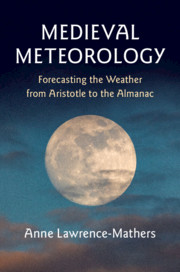Book contents
- Medieval Meteorology
- Medieval Meteorology
- Copyright page
- Contents
- Preface
- Acknowledgements
- Introduction
- 1 Recreating Meteorology in the Early Middle Ages
- 2 Meteorology, Weather Forecasting and the Early Medieval Renaissance of Astronomy
- 3 Exploratory Encounters with the Work of Arab Astronomers and Meteorologists
- 4 Meteorology, the New Science of the Stars and the Rise of Weather Forecasting
- 5 The Contested Rise of Astrometeorology
- 6 Applying the Science of Astrometeorology
- 7 Astrometeorology and Mechanisation
- 8 Weather Forecasting and the Impact of Print
- Conclusion
- Bibliography
- Index
5 - The Contested Rise of Astrometeorology
Published online by Cambridge University Press: 08 November 2019
- Medieval Meteorology
- Medieval Meteorology
- Copyright page
- Contents
- Preface
- Acknowledgements
- Introduction
- 1 Recreating Meteorology in the Early Middle Ages
- 2 Meteorology, Weather Forecasting and the Early Medieval Renaissance of Astronomy
- 3 Exploratory Encounters with the Work of Arab Astronomers and Meteorologists
- 4 Meteorology, the New Science of the Stars and the Rise of Weather Forecasting
- 5 The Contested Rise of Astrometeorology
- 6 Applying the Science of Astrometeorology
- 7 Astrometeorology and Mechanisation
- 8 Weather Forecasting and the Impact of Print
- Conclusion
- Bibliography
- Index
Summary
Chapter 5 traces the evidence for the practice of astrometeorology by scholars and professionals in the service of the European elite. This phenomenon faced criticism from those who feared the rise of judicial astrology and the associated threat of demonic intervention. The chapter analyses the level of meteorological knowledge displayed by scholars such as William of Conches, adviser to Geoffrey of Anjou. William knew works attributed to Masha’allah as well as Seneca, and deployed the new, scientific terminology that spread in the twelfth century. A key point is that works like William’s depict secular rulers as keenly interested in understanding and predicting the weather. From this the chapter moves on to the more advanced astrometeorological teachings of Abraham Ibn Ezra, a Jewish scholar from al Andalus who travelled across Italy and Spain. One of his innovations was to provide tables of mathematical values to be applied to astrometeorological configurations, making forecasting much simpler. This was to be followed by others in the thirteenth century. The chapter ends with comment on the scarcity of surviving twelfth-century copies of these works.
Keywords
- Type
- Chapter
- Information
- Medieval MeteorologyForecasting the Weather from Aristotle to the Almanac, pp. 110 - 133Publisher: Cambridge University PressPrint publication year: 2019

